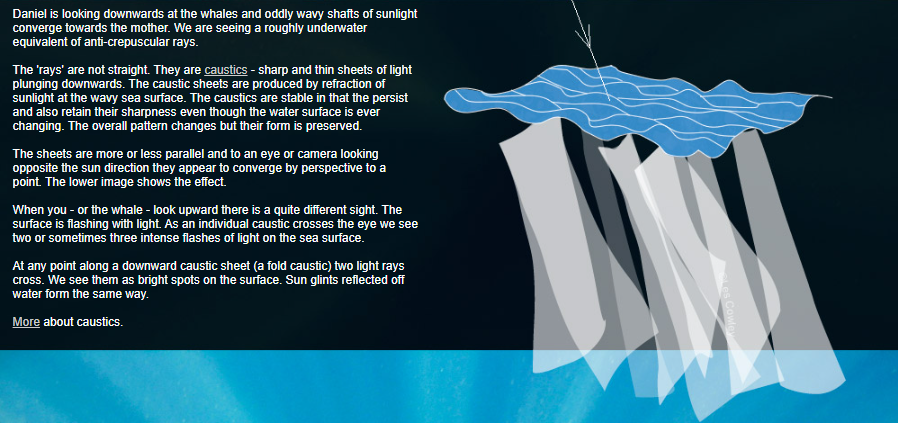OPOD - Anticrepuscular Whales?
OPOD - Anticrepuscular Whales?
Have you ever seen a mesmerizing sight where rays of sunlight converge towards a majestic whale swimming in the ocean? If so, you may have witnessed a phenomenon known as anticrepuscular rays. These underwater rays, similar to their atmospheric counterparts, create a stunning display of light and shadow that captivates the observer. In this article, we will explore the intriguing concept of anticrepuscular rays and their connection to the presence of whales.
When observing the underwater scene captured by Daniel Perez in Papeete bay, Tahiti, we notice the peculiar convergence of wavy shafts of sunlight towards the mother whale. These converging rays resemble anti-crepuscular rays, which are commonly observed in the sky during sunrise or sunset. However, the underwater environment introduces a fascinating twist to this phenomenon.
The "rays" we see in the image are not straight but rather appear as caustics – thin and sharp sheets of light plunging downwards. These caustic sheets are formed due to the refraction of sunlight at the wavy surface of the sea. Despite the ever-changing nature of the water surface, these caustics remain stable, retaining their sharpness and form. Although the overall pattern may vary, their essential characteristics persist.
To an observer positioned opposite the direction of the sun, the caustic sheets appear parallel and seem to converge perspective-wise towards a point. This convergence creates a captivating visual effect, enhancing the ethereal beauty of the underwater scene. The lower image provides a clearer depiction of this phenomenon, showcasing the effect of converging caustic sheets.
When we shift our gaze upwards, an entirely different spectacle unfolds before our eyes. Looking towards the water's surface, we witness a mesmerizing display of flashing lights. As individual caustic sheets cross our line of sight, we perceive two or sometimes three intense flashes of light on the sea surface. These flashes result from the intersection of two light rays along a downward caustic sheet, known as a fold caustic. Interestingly, the same phenomenon occurs when sunlight reflects off the water, creating sun glints.
The existence of caustics and their impact on the underwater environment extends beyond their aesthetic appeal. Understanding these phenomena can provide valuable insights into the behavior and interactions of marine life, such as whales. The convergence of sunlight towards a whale in this particular instance highlights the intricate relationship between these magnificent creatures and their environment.
As we delve deeper into the concept of caustics, it becomes evident that they play a significant role in shaping our perception of light underwater. Caustics occur when light rays pass through a medium with varying refractive properties, causing them to bend and concentrate in certain areas. These concentrated areas manifest as bright spots or sheets of light, creating stunning visual effects.
In addition to their aesthetic allure, caustics serve practical purposes in various fields of study. Researchers studying underwater ecosystems utilize caustics to gain insights into the distribution and behavior of marine organisms. By analyzing the patterns and characteristics of caustics, scientists can decipher crucial information about the movement and interaction of underwater life forms.
In conclusion, the captivating phenomenon of anticrepuscular rays finds a unique manifestation underwater, as demonstrated by Daniel Perez's remarkable image of whales surrounded by converging shafts of sunlight. The convergence of caustic sheets creates an awe-inspiring spectacle that mesmerizes observers. Understanding the intricacies of caustics not only enhances our appreciation for the beauty of nature but also provides valuable insights into the behavior and dynamics of marine life. So, the next time you encounter an enchanting display of light and shadow underwater, take a moment to marvel at the interplay between sunlight, caustics, and the magnificent creatures that inhabit our oceans.



Anticrepuscular Whales?
Underwater image by Daniel Perez at Papeete bay, Tahiti. Rays appear to be converging on the whale. Why? ©Daniel Perez, shown with permission.
Daniel is looking downwards at the whales and oddly wavy shafts of sunlight converge towards the mother. We are seeing a roughly underwater equivalent of anti-crepuscular rays.
The 'rays' are not straight. They are caustics - sharp and thin sheets of light plunging downwards. The caustic sheets are produced by refraction of sunlight at the wavy sea surface. The caustics are stable in that the persist and also retain their sharpness even though the water surface is ever changing. The overall pattern changes but their form is preserved.
The sheets are more or less parallel and to an eye or camera looking opposite the sun direction they appear to converge by perspective to a point. The lower image shows the effect.
When you - or the whale - look upward there is a quite different sight. The surface is flashing with light. As an individual caustic crosses the eye we see two or sometimes three intense flashes of light on the sea surface.
At any point along a downward caustic sheet (a fold caustic) two light rays cross. We see them as bright spots on the surface. Sun glints reflected off water form the same way.
More about caustics.
Note: this article has been automatically converted from the old site and may not appear as intended. You can find the original article here.
Reference Atmospheric Optics
If you use any of the definitions, information, or data presented on Atmospheric Optics, please copy the link or reference below to properly credit us as the reference source. Thank you!
-
<a href="https://atoptics.co.uk/blog/opod-anticrepuscular-whales/">OPOD - Anticrepuscular Whales?</a>
-
"OPOD - Anticrepuscular Whales?". Atmospheric Optics. Accessed on April 19, 2024. https://atoptics.co.uk/blog/opod-anticrepuscular-whales/.
-
"OPOD - Anticrepuscular Whales?". Atmospheric Optics, https://atoptics.co.uk/blog/opod-anticrepuscular-whales/. Accessed 19 April, 2024
-
OPOD - Anticrepuscular Whales?. Atmospheric Optics. Retrieved from https://atoptics.co.uk/blog/opod-anticrepuscular-whales/.